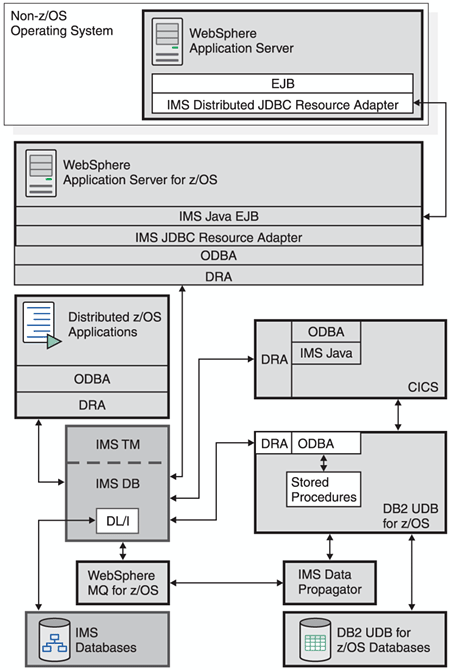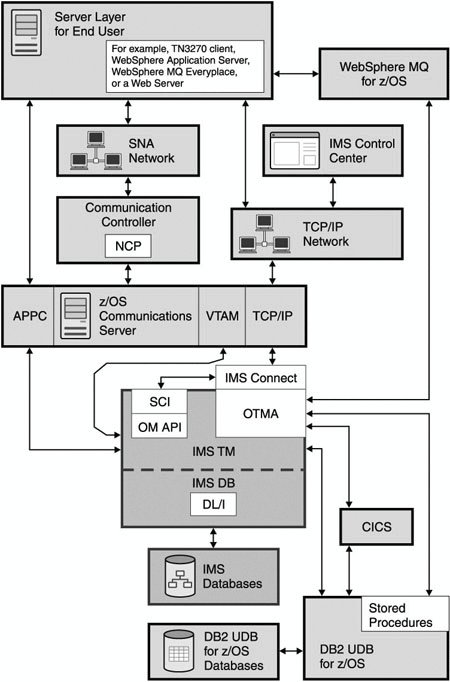| The scope of this book is not large enough to fully explain all the products and protocols that can access IMS. Instead, some of these products and protocols are briefly mentioned in the following sections to demonstrate that you can access IMS from almost anywhere in the IT world. Some products are shown in both Figure 3-3 on page 23 and Figure 3-4 on page 25, which indicates that these products can access both IMS DB and IMS TM. Figure 3-3. Accessing IMS DB from Other Programs 
Figure 3-4. Accessing IMS TM from Other Programs 
Accessing IMS DB Figure 3-3 shows the main interfaces to IMS DB (IMS TM, the ODBA interface, and the DRA interface), along with some of the products that use the ODBA and DRA interfaces. The following components and products are shown in Figure 3-3: DL/I. DRA: The DRA comes with IMS DB, but is run where it is used, not within IMS. ODBA: ODBA comes with IMS DB, but, like the DRA, is run where it is used, not within IMS. Distributed z/OS applications: Any z/OS application that follows the guidelines and rules associated with the ODBA interface can access IMS. WebSphere Application Server for z/OS. CICS: IBM CICS Transaction Server for z/OS, an IBM licensed program that provides online transaction-processing services and management for business applications. CICS can be a transaction manager for either IMS DB or DB2 UDB for z/OS. In Figure 3-3, CICS application programs that need to access IMS DB can do so in two ways: - Directly through the DRA by issuing CICS EXEC DL/I calls. - Through the DRA using the IMS Java function and issuing the supported SQL calls.
DB2 UDB for z/OS: IBM's premier database manager for relational databases. Stored procedures that run in DB2 UDB for z/OS can access IMS DB through ODBA. IBM WebSphere MQ for z/OS: A z/OS subsystem that supports the transfer of messages across z/OS address spaces and to other WebSphere MQ products on both IBM and non-IBM platforms. The platforms include AIX®, iSeries™, OS/2®, VSE/ESA™, HP-UX, Solaris, Windows, Compaq NonStop Kernel, Compaq Tru64 UNIX, Compaq Open VMS (Alpha), and Linux, using the IBM SNA LU 6.2 or TCP/IP communications protocols. IBM IMS DataPropagator™: Figure 3-3 also shows WebSphere MQ for z/OS working in conjunction with IMS DataPropagator and DB2 UDB for z/OS to replicate IMS data across the DB2 family of databases.
Accessing IMS TM Figure 3-4 on page 25 shows the main interfaces to IMS TM (the OTMA interface, the IMS Connect function, VTAM, and APPC), along with some of the products and protocols that use these interfaces. The following components and products are shown in Figure 3-4: DL/I. Advanced Program-to-Program Communications (APPC): An implementation of the SNA LU 6.2 protocol that allows interconnected systems to communicate and share the processing of programs. For more information about IMS TM and APPC, see "APPC/IMS and LU 6.2 Devices" on page 185. z/OS Communications Server: z/OS Communications Server provides both System Network Architecture (SNA) and Transmission Control Protocol/Internet Protocol (TCP/IP) networking protocols for z/OS. The SNA protocols are provided by Virtual Telecommunications Access Method (VTAM) and include Subarea, Advanced Peer-to-Peer Networking, and High Performance Routing protocols. For more information on z/OS Communications Server SNA protocols or TCP/IP networking protocols for z/OS, see z/OS V1R4.0 z/OS Communications Server SNA Network Implementation Guide. Communication Controller and Network Control Program (NCP): A combination of hardware and software that provides support for single-domain, multiple-domain, and interconnected network capability. The NCP is an IBM licensed program. SNA Network: Existing (traditional) network that implements the SNA protocols[3] to connect terminals and other devices. [3] Network access to IMS Transaction Manager was originally provided by IBM's communications systems, which evolved into the System Network Architecture (SNA), as implemented in VTAM.
Server Layer for End User: One or more middleware software products that interact with the end user, for example, TN3270 client (TN3270 Telnet server acts as an interface between IP and SNA networks), WebSphere Application Server, or WebSphere MQ Everyplace®. IMS Control Center: A workstation graphical interface from which you can manage your IMS systems. The IMS Control Center connects to IMS through a TCP/IP network, IMS Connect, and the Structured Call Interface (SCI). For more information about SCI, see Chapter 28, "IMSplexes" on page 495. For more information about the IMS Control Center, see "Operating an IMSplex" on page 499. For more information about IMS Connect, see "IMS Connect" on page 187. OTMA: An open interface to IMS TM through which a z/OS or TCP/IP application program can send a transaction or command to IMS without using SNA or VTAM. For more information about OTMA, see "Open Transaction Manager Access" on page 179. IBM WebSphere MQ for z/OS: A z/OS subsystem that supports the transfer of messages across z/OS address spaces and to other WebSphere MQ products on both IBM and non-IBM platforms. The platforms include AIX, iSeries, OS/2, VSE/ESA, HP-UX, Solaris, Windows, Compaq NonStop Kernel, Compaq Tru64 UNIX, Compaq OpenVMS (Alpha), and Linux, using the SNA LU 6.2 or TCP/IP communications protocols. CICS: In Figure 3-4 on page 25, CICS application programs that need to access IMS TM can do so by using the OTMA callable interface. DB2 UDB for z/OS: IBM's premier database manager for relational databases. IMS TM can provide transaction processing services for DB2 UDB for z/OS.
|

